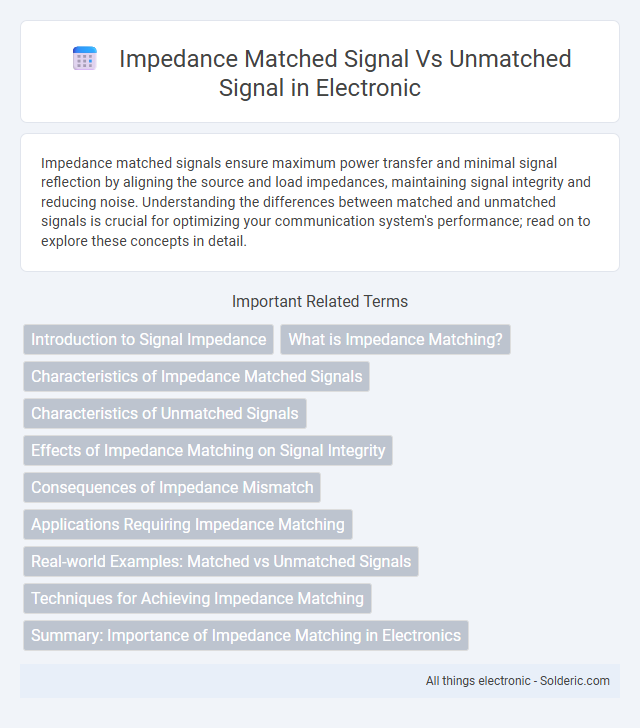Impedance matched signals ensure maximum power transfer and minimal signal reflection by aligning the source and load impedances, maintaining signal integrity and reducing noise. Understanding the differences between matched and unmatched signals is crucial for optimizing your communication system's performance; read on to explore these concepts in detail.
Comparison Table
| Aspect | Impedance Matched Signal | Impedance Unmatched Signal |
|---|---|---|
| Signal Integrity | High - minimal reflections and distortion | Low - signal reflections cause distortion |
| Power Transfer | Optimal - maximum power delivered | Suboptimal - power loss due to mismatch |
| Reflection Coefficient (G) | Close to 0 (ideal match) | Greater than 0 (causes reflections) |
| Signal Bandwidth | Wide bandwidth supported | Reduced bandwidth due to reflections |
| Transmission Line Effect | Minimized signal distortion | Increased signal loss and ringing |
| Use Case | High-frequency RF, data communication | Low-frequency or non-critical signals |
| System Efficiency | Maximized | Reduced |
Introduction to Signal Impedance
Signal impedance refers to the characteristic resistance that a signal encounters as it travels through a transmission line. Impedance-matched signals occur when the source impedance equals the load impedance, minimizing reflections and maximizing power transfer. Unmatched signals cause impedance mismatches that result in signal reflections, distortion, and reduced signal integrity.
What is Impedance Matching?
Impedance matching refers to the process of designing the input and output impedances of electronic components or transmission lines to be equal, minimizing signal reflections and power loss. In impedance matched signals, maximum power transfer occurs because the source impedance equals the load impedance, ensuring signal integrity and reducing distortion. Unmatched signals result in reflections, signal degradation, and reduced efficiency due to impedance mismatches in the transmission path.
Characteristics of Impedance Matched Signals
Impedance matched signals exhibit minimal signal reflection and maximum power transfer, ensuring signal integrity over transmission lines. These signals maintain consistent amplitude and phase, reducing distortion and electromagnetic interference. High-frequency applications benefit from impedance matching by achieving efficient signal transmission and reducing signal loss.
Characteristics of Unmatched Signals
Unmatched signals experience signal reflections and standing waves due to impedance discontinuities, causing distortion and signal loss. These reflections reduce signal integrity and increase electromagnetic interference (EMI), adversely affecting your system's performance. Proper impedance matching is critical to minimizing these effects and ensuring efficient power transfer.
Effects of Impedance Matching on Signal Integrity
Impedance matching significantly enhances signal integrity by minimizing reflections and signal loss, ensuring maximum power transfer between components in a transmission line. An impedance-matched signal maintains waveform quality and reduces electromagnetic interference, leading to clearer and more reliable data transmission. Your system's performance improves when impedance mismatch is avoided, preventing distortions and potential data errors.
Consequences of Impedance Mismatch
Impedance mismatch between a signal source and load causes signal reflections, resulting in distorted waveforms and potential data errors. This mismatch increases signal attenuation and reduces power transfer efficiency, leading to slower signal transmission and degraded system performance. In high-frequency applications, impedance mismatch can cause standing waves, which damage components and further degrade signal integrity.
Applications Requiring Impedance Matching
Impedance matched signals are critical in high-frequency applications such as RF transmission lines, audio systems, and high-speed digital circuits to ensure maximum power transfer and minimize signal reflections. Unmatched signals often cause signal loss, distortion, and electromagnetic interference, severely affecting performance in telecommunications and data communication systems. Devices like antennas, transmission lines, and integrated circuits commonly require precise impedance matching to maintain signal integrity and optimize system efficiency.
Real-world Examples: Matched vs Unmatched Signals
In RF communication systems, impedance matched signals ensure maximum power transfer and minimize signal reflection, as seen in coaxial cable connections between antennas and transmitters. Unmatched signals often cause signal degradation and standing waves, exemplified by improper termination in audio cables resulting in noise and distortion. Network analyzers are commonly used to measure and optimize impedance matching for improved signal integrity in practical applications.
Techniques for Achieving Impedance Matching
Techniques for achieving impedance matching include using quarter-wave transformers, LC matching networks, and baluns to minimize signal reflection and maximize power transfer. Proper selection of components based on frequency and load characteristics ensures effective impedance matching in RF and communication systems. You can optimize signal integrity and reduce loss by applying these methods tailored to your system's specific impedance requirements.
Summary: Importance of Impedance Matching in Electronics
Impedance matching in electronics is crucial for maximizing power transfer and minimizing signal reflections in transmission lines and circuits. An impedance matched signal ensures optimal energy flow, reduces signal loss, and prevents distortion, thereby enhancing overall system performance and reliability. Your electronic designs benefit significantly from proper impedance matching by improving signal integrity and preventing potential damage to components.
impedance matched signal vs unmatched signal Infographic

 solderic.com
solderic.com